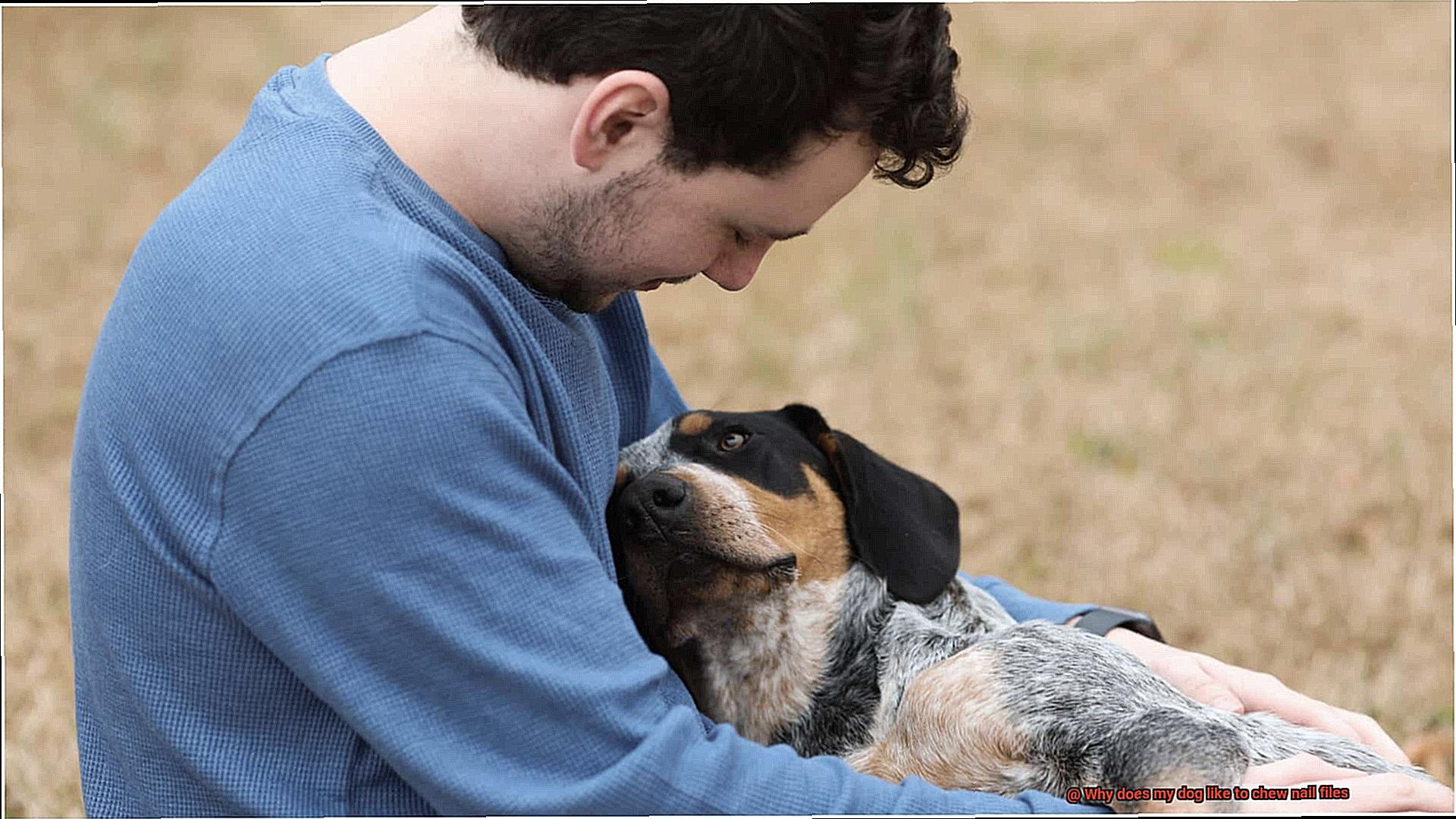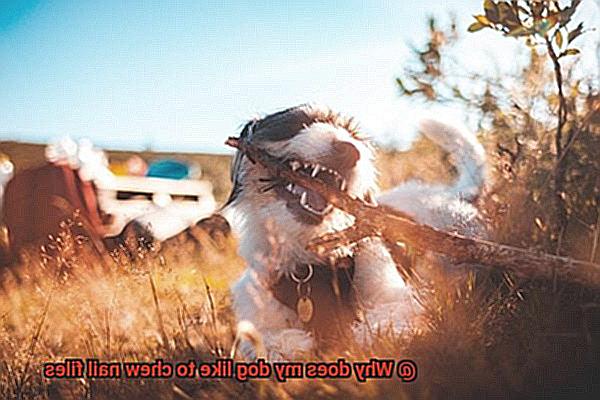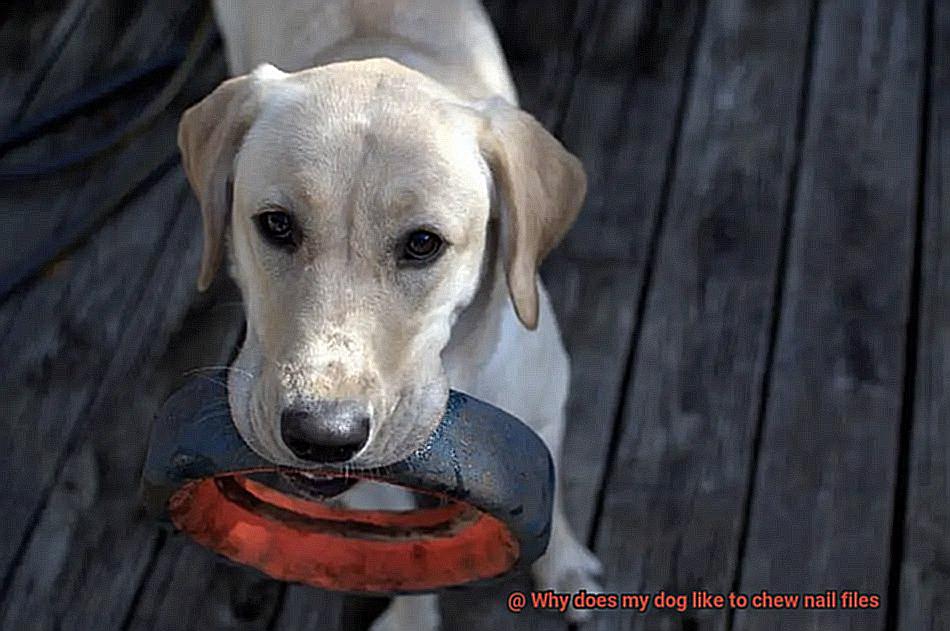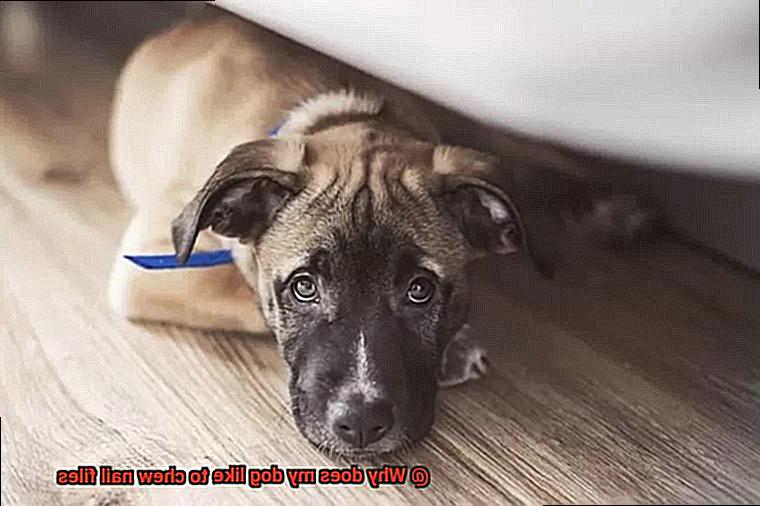Have you ever caught your furry friend munching on your nail file like it’s a delicious treat? Don’t worry, your dog isn’t trying to sabotage your perfectly polished nails. Believe it or not, chewing on nail files is a common canine behaviour that can leave many pet owners scratching their heads in confusion.
Dogs have an innate desire to chew, which helps them explore their surroundings and alleviate the discomfort of teething. But why do so many pups gravitate towards nail files specifically?
One theory suggests that the rough texture of the file provides a satisfying sensation for dogs who prefer to chew on harder objects. Additionally, the scent of nail polish remover or lotion used during human manicures may attract dogs to these grooming tools.
While nibbling on a nail file may seem harmless at first, it’s important to keep an eye on your pup and ensure they aren’t swallowing any small pieces of the file. To satisfy their chewing needs safely, consider offering them a variety of chew toys or bones made specifically for dogs.
Your dog’s affinity for gnawing on nail files is just another quirky habit in their repertoire of amusing behaviours. Now if only we could convince them to stop stealing our socks…
What is Chewing on Nail Files?
Dogs are notorious chewers, and they’ll chomp on just about anything that catches their fancy. One such item that may pique their interest is the humble nail file. Chewing on nail files can be concerning for pet owners, as these items are often made of abrasive materials like sandpaper or emery boards that can cause damage to a dog’s teeth and gums if ingested.

Why do dogs like to chew on nail files? One reason is that they find the texture and taste appealing. Dogs have a natural urge to chew, and nail files may provide a satisfying sensory experience for them. Additionally, the rough texture of a nail file may help to soothe an itchy or irritated gum line, much like how humans use dental floss to relieve discomfort.
However, excessive chewing on nail files can be a sign of more serious issues. If a dog is experiencing dental pain or discomfort, they may turn to chewing on hard objects like nail files as a way to alleviate their symptoms. Similarly, dogs who suffer from separation anxiety or other forms of stress may engage in destructive chewing behaviors as a coping mechanism.
To prevent your furry friend from chomping on nail files, provide them with appropriate chew toys and bones. These items not only satisfy your dog’s natural urge to chew but also promote healthy teeth and gums. Furthermore, supervising your dog while they chew can ensure that they don’t ingest any harmful objects.
It’s essential to pay attention to your dog’s behavior and seek veterinary advice if necessary. Excessive chewing on hard objects like nail files may be a sign of dental pain or discomfort. Similarly, dogs who are stressed or anxious may turn to destructive chewing behaviors as a coping mechanism. By addressing these underlying issues, you can help your dog break the habit of chewing on dangerous items like nail files.
Reasons Why Dogs Like to Chew Nail Files
Dogs are known for their love of chewing, and nail files are no exception. But why exactly do dogs find nail files so irresistible? Here are five possible reasons:

Texture
The rough surface of a nail file can provide a satisfying sensation for dogs when they chew on it. It can also help relieve discomfort caused by teething or dental issues, and keep their teeth and gums healthy.
Taste and Smell
Some nail files are made from materials that have a pleasant taste or smell, making them even more appealing to dogs. Even if the nail file doesn’t taste good, the texture can still be satisfying for dogs to chew on.
Boredom
Dogs that are left alone for long periods of time may experience boredom, and chewing on a nail file can provide a stimulating activity to keep them occupied and entertained.
Anxiety
Dogs that experience anxiety or stress may also turn to chewing as a way to cope with their emotions. Chewing can be a calming activity for dogs, helping them to release pent-up energy or anxiety. In this case, chewing on a nail file may serve as a form of self-soothing behavior.

Attention-Seeking Behavior
Some dogs may chew on objects like nail files in order to get attention from their owners. Chewing can be a way for dogs to communicate their needs or desires, especially if they are feeling neglected or ignored.
While chewing on a nail file may seem harmless, it can actually be dangerous for dogs. Pieces of the file can break off and be swallowed, leading to intestinal blockages or other health problems. Ingesting abrasive materials like nail files can also cause damage to a dog’s teeth and gums.
To prevent your dog from chewing on inappropriate objects like nail files, make sure they have plenty of appropriate chew toys and bones available. These items not only satisfy a dog’s natural urge to chew but also promote healthy teeth and gums. Additionally, it is important to supervise dogs when they are chewing to ensure that they do not ingest any harmful objects.
Potential Health Risks of Chewing on Nail Files
This seemingly harmless behavior can pose various health risks to your pooch. Nail files are made of abrasive materials, such as metal or sandpaper, which can cause significant damage to your dog’s teeth and gums if chewed on regularly.
One of the most significant risks of chewing on nail files is tooth damage. Dogs’ teeth are not designed to withstand the constant abrasion of hard materials like metal or sandpaper, which can lead to wear and erosion of the enamel over time. Ultimately, this can result in tooth fractures that can be painful and require veterinary intervention.
Another potential risk is the ingestion of nail file material. If your dog swallows any pieces during their chewing frenzy, it can lead to internal damage or blockages. The abrasive nature of nail files can also cause irritation or inflammation in your dog’s digestive tract, leading to discomfort or diarrhea.
In addition to this, chewing on nail files can also lead to injury to your dog’s gums. The rough surface of the file can cause lacerations or cuts that can become infected if left untreated. This can be especially problematic for dogs with compromised immune systems, as infections can quickly become serious.
It is crucial to recognize the potential health risks involved in this behavior and take appropriate action. To prevent these potential health risks from becoming a reality for your furry friend, discourage them from chewing on nail files and provide appropriate chew toys or treats instead. If you notice any signs of dental or gum damage from chewing on nail files, seek veterinary care immediately to prevent further complications.
How to Prevent Your Dog from Chewing on Nail Files
This habit can be harmful to your pet’s health, but luckily, there are ways to prevent it. Here are five sub-sections with tips on how to prevent your dog from chewing on nail files.
Identify the Underlying Cause
Before you start preventing your dog’s nail file chewing habit, it’s important to understand why they are doing it. Is it due to boredom, anxiety, or a lack of appropriate chew toys? Once you identify the root cause, you can take steps to address and redirect their behavior.
Provide Mental and Physical Stimulation

Dogs need plenty of mental and physical stimulation to stay healthy and happy. Make sure your dog gets enough exercise throughout the day by going for walks or playing fetch. Additionally, providing puzzle toys that require problem-solving skills will keep their minds engaged.
Store Nail Files Out of Reach
To prevent your dog from accessing nail files, store them in a locked drawer or cabinet that is out of your pet’s reach. This eliminates the temptation for your dog to chew on them.
Offer Appropriate Chew Toys
Give your furry friend appropriate chew toys designed for their chewing habits. This will keep them occupied and prevent them from seeking out other objects to chew on. Rubber chew toys, dental chews, or bones are great options.
Train and Reinforce Positive Behavior
When you catch your dog chewing on something they shouldn’t, redirect their attention to an appropriate chew toy and reward them when they use it. Consistency is key in this approach, so be sure to reinforce this behavior regularly.
If the above tips don’t work, it might be helpful to seek professional help from a veterinarian or professional dog trainer. They can offer additional advice and guidance on how to manage this behavior and prevent any potential harm to your pet’s health.
Appropriate Toys and Bones for Dogs Who Like to Chew
Providing your furry friend with appropriate toys and bones to chew on is essential to promote their overall health and wellbeing. Let’s explore the best options for dogs who love to chew.
Firstly, chew toys made of durable rubber are perfect for heavy chewers. These toys, such as those from reputable brands like Kong and Nylabone, are designed to withstand the most vigorous chewing and can even be filled with treats to enhance the appeal.
Another great option for dogs who love to chew is natural bones, such as rawhide or marrow bones. Not only do these bones satisfy your dog’s urge to chew, but they also help keep their teeth clean and healthy. However, it’s crucial to supervise your dog while they’re chewing on these bones to prevent any choking hazards or broken teeth.
It’s also vital to avoid giving your dog toys or bones that are too small or easily breakable, as these can pose serious choking hazards. Additionally, never give your dog anything that’s not meant for them, including children’s toys or human food items, which can cause digestive issues or even be toxic.
Providing appropriate toys and bones for your dog who likes to chew is not only beneficial for their physical health but also their mental wellbeing. Chewing can help relieve stress and anxiety in dogs, making it an important part of their daily routine.
Supervising Your Dog When They are Chewing
This includes supervising your dog when they are chewing. Chewing is a natural behavior for dogs, but it can quickly become destructive and even dangerous if they start chewing on items like nail files. Here are some tips to help you supervise your dog’s chewing behavior:
Provide Appropriate Chew Toys

One of the best ways to redirect your dog’s chewing behavior is by providing them with appropriate chew toys. Choose toys that are durable, safe, and specially designed for your dog’s size and breed. Rotate their toys frequently to keep them interested and engaged.
Monitor Their Behavior
Actively monitoring your dog while they’re chewing is essential to prevent destructive behavior. Keep an eye on them and intervene if necessary. If you notice that your dog is chewing on something they shouldn’t be, calmly redirect their attention to an appropriate chew toy or remove the item from their reach.
Ensure Plenty of Exercise and Mental Stimulation
Exercise and mental stimulation are vital for preventing destructive behavior. Make sure your dog has regular opportunities for playtime, walks, and training sessions. This can help reduce stress and anxiety, which in turn reduces the likelihood of destructive chewing behavior.
Establish Clear Boundaries and Rules
Establishing clear boundaries and rules for behavior in your home is crucial. This can include crate training or using baby gates to limit access to certain areas of the house. Consistency is key when it comes to establishing these rules, as dogs thrive on routine and predictability.
Dental Problems That Can Occur From Chewing On Nail Files
There is one item that may seem innocuous but can actually cause serious dental problems: a nail file.

Chewing on nail files can lead to a variety of dental issues such as tooth fractures, gum irritation and inflammation, and enamel erosion. Let’s take a closer look at each of these problems.
Tooth fractures are one of the most common dental problems that can occur from chewing on nail files. The hard surface of the file can cause a dog’s teeth to crack or break, which can be incredibly painful and require costly dental procedures. If left untreated, it can also lead to infections, which can be life-threatening for your pet.
Gum irritation and inflammation are another potential issue. The rough surface of the nail file can cause damage to a dog’s gums, leading to redness, swelling, and bleeding. This can make it difficult for your pup to eat or drink, resulting in weight loss and dehydration.
Enamel erosion is yet another concern. Enamel is the protective outer layer of a dog’s teeth, and when it wears away, it can leave the teeth vulnerable to decay and cavities. Chewing on nail files can speed up this process and lead to serious dental problems down the line, which can be incredibly painful for your pet.
To prevent these issues from occurring, it’s crucial for dog owners to monitor their pets’ behavior and prevent them from chewing on non-food items like nail files. Providing appropriate chew toys and regularly brushing their teeth can help maintain good dental health.
Digestive Issues That Can Occur From Ingesting Pieces of The File
Sometimes, our pets can get into mischief and chew on things they shouldn’t, such as nail files. Unfortunately, ingesting even a small piece of the file can lead to serious digestive issues for your dog.
At first, you may notice mild symptoms such as gastrointestinal upset, including vomiting, diarrhea, and abdominal pain. These symptoms can be uncomfortable for your pet and may require medical attention if they persist. But if left untreated, the sharp edges of the file can cause damage to the lining of the digestive tract, leading to irritation and inflammation.
In more severe cases, ingesting a nail file can cause a blockage in the digestive tract. This is a dangerous condition that requires immediate medical attention. You may notice that your dog appears lethargic and has a lack of appetite in addition to vomiting and constipation.
Another potential issue is perforation or puncture of the digestive tract. This occurs when a sharp piece of the file pierces through the lining of the stomach or intestines, causing damage and allowing bacteria to enter the body cavity. This is a serious condition that requires emergency veterinary care.
While some dogs may naturally pass ingested pieces of nail files through their stool, it’s important to monitor your pet closely and seek veterinary care if you notice any signs of digestive distress or suspect that they have ingested a foreign object.
To prevent these potential digestive issues from occurring in the first place, it’s important to keep nail files out of your dog’s reach. Instead, provide safe and appropriate chew toys that will satisfy their chewing needs without putting their health at risk. You could try offering them rawhide chews or toys specifically designed for chewing.
nqUXKwIehEs” >
Conclusion
In conclusion, it’s important to understand the reasons behind your dog’s attraction to nail files and the potential dangers associated with this behavior. Dogs may be drawn to the texture, taste, and smell of these objects or may be chewing out of boredom or anxiety.
However, excessive chewing can lead to serious dental problems like tooth fractures, gum irritation and inflammation, and enamel erosion. Ingesting pieces of the file can also cause digestive issues such as vomiting, diarrhea, abdominal pain, blockages in the digestive tract, or even perforation of the digestive tract.
To protect your furry friend from harm and prevent them from chewing on inappropriate items like nail files, provide them with safe chew toys and bones specifically designed for dogs.
Keep a close eye on their behavior while they’re chewing to ensure they don’t ingest any harmful objects. And if you notice any signs of dental or gum damage or suspect that your dog has ingested a foreign object, seek veterinary care immediately.







